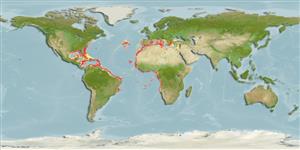>
Gadiformes (Cods) >
Macrouridae (Grenadiers or rattails)
Etymology: Hymenocephalus: Named for its transparent membrane-like head covering (‘‘hymen head’’) and fragile nature of head bones (Ref. 100825).
Environment: milieu / climate zone / depth range / distribution range
Ecología
marino bentopelágico; no migratorio; rango de profundidad 100 - 1400 m (Ref. 3587). Subtropical; 43°N - 20°S, 97°W - 35°E (Ref. 1371)
Widespread: common in the tropical western Atlantic; Eastern Atlantic: from Portugal to Angola), the Mediterranean. Western Indian Ocean: off southern Somalia to Zanzibar, off Mozambique to Durban, along the Mascarene Ridge and off Maldives (Ref. 98298); including Gulf of Aden and Zanzibar (Ref. 26165).
Length at first maturity / Tamaño / Peso / Age
Maturity: Lm 2.7, range 3 - 4 cm
Max length : 25.0 cm TL macho / no sexado; (Ref. 3397); edad máxima reportada: 9 años (Ref. 58045)
Most common at depths less than 500 m (Ref. 1371). Feeds predominantly on pelagic copepods, to a lesser extent on euphausiids and gammarian amphipods, and to a minor extent on shrimps, ostracods, cumaceans, other small crustaceans, and small fish (Ref. 1371). Due to its small size, it is not of significant interest to fisheries (Ref. 1371).
Life cycle and mating behavior
Maturities | Reproducción | Spawnings | Egg(s) | Fecundities | Larva
Cohen, D.M., T. Inada, T. Iwamoto and N. Scialabba, 1990. FAO species catalogue. Vol. 10. Gadiform fishes of the world (Order Gadiformes). An annotated and illustrated catalogue of cods, hakes, grenadiers and other gadiform fishes known to date. FAO Fish. Synop. 125(10). Rome: FAO. 442 p. (Ref. 1371)
IUCN Red List Status (Ref. 130435)
Threat to humans
Harmless
Human uses
Herramientas
Warning: mysqli::__construct(): (HY000/1040): Too many connections in /var/www/html/includes/speciessummary.lib.php on line 2104
Can't connect to MySQL database fbquizv2. Errorcode: Too many connections
